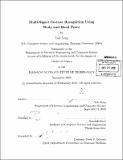Multi-signal gesture recognition using body and hand poses
Author(s)
Song, Yale
DownloadFull printable version (16.78Mb)
Other Contributors
Massachusetts Institute of Technology. Dept. of Electrical Engineering and Computer Science.
Advisor
Randall Davis.
Terms of use
Metadata
Show full item recordAbstract
We present a vision-based multi-signal gesture recognition system that integrates information from body and hand poses. Unlike previous approaches to gesture recognition, which concentrated mainly on making it a signal signal, our system allows a richer gesture vocabulary and more natural human-computer interaction. The system consists of three parts: 3D body pose estimation, hand pose classification, and gesture recognition. 3D body pose estimation is performed following a generative model-based approach, using a particle filtering estimation framework. Hand pose classification is performed by extracting Histogram of Oriented Gradients features and using a multi-class Support Vector Machine classifier. Finally, gesture recognition is performed using a novel statistical inference framework that we developed for multi-signal pattern recognition, extending previous work on a discriminative hidden-state graphical model (HCRF) to consider multi-signal input data, which we refer to Multi Information-Channel Hidden Conditional Random Fields (MIC-HCRFs). One advantage of MIC-HCRF is that it allows us to capture complex dependencies of multiple information channels more precisely than conventional approaches to the task. Our system was evaluated on the scenario of an aircraft carrier flight deck environment, where humans interact with unmanned vehicles using existing body and hand gesture vocabulary. When tested on 10 gestures recorded from 20 participants, the average recognition accuracy of our system was 88.41%.
Description
Thesis (S.M.)--Massachusetts Institute of Technology, Dept. of Electrical Engineering and Computer Science, 2010. Cataloged from PDF version of thesis. Includes bibliographical references (p. 147-154).
Date issued
2010Department
Massachusetts Institute of Technology. Department of Electrical Engineering and Computer SciencePublisher
Massachusetts Institute of Technology
Keywords
Electrical Engineering and Computer Science.